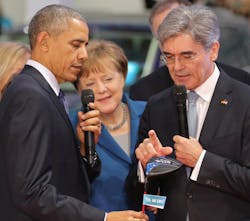Beginning with Siemens CEO and President Joe Kaeser’s presentation at the Economic Forum during the opening ceremony at Hannover Messe 2016, the company’s message at the event was overwhelmingly focused on the digitalization of production and Industry 4.0. This was not a unique angle, however. If you didn't catch the drift that digitalization is the future of manufacturing at Hannover Messe 2016, you probably weren’t there.
What set Siemens’ message apart was the depth of the company’s involvement in this technology trend beyond its role as a supplier. To be sure, the company made a lot of noise about numerous products designed for digital industry, such as its TIA Portal v14 with its new Cloud Connector capabilities, a new interface to TeamCenter for integrated product data management, and several new simulation and virtualization capabilities. The company also heavily promoted the new MindSphere—Siemens' Cloud for Industry offering. Hosted on SAP’s HANA cloud platform, MindSphere will reportedly allow for online monitoring of globally distributed industrial devices—from robots and machine tools to compressors and pumps—as well as the creation of digital plant models for process simulation and optimization. It can also be used to create web services and apps for operations such as energy data management and predictive maintenance. With an OPC-based interface, MindSphere can be used with all Siemens and SAP products, as well as those from other suppliers.
Potentially more impactful than its offering of Industry 4.0-ready products, however, is the example Siemens is setting forth as a manufacturer deploying such technologies to improve its own operations.
For example, at Siemens' PLC manufacturing plant in Amberg, Germany, the company has taken digitalization to the point where it has automated the production of its automation systems. The result is a reported 99.99885 percent “perfect” production quality rate—an impressive rate given the plant produces 12 million Simatic PLCs each year. Considering that the plant operates 230 days each year, that translates into the production of one PLC every operating second.
According to Siemens, 75 percent of the PLC production process at Amberg is automated. People play a role in the production process at the beginning, to place the bare circuit board on the production line that will become the heart of the PLC. Interestingly, Simatic PLCs are used in the production of the Simatic PLCs. Siemens says about 1,000 Simatic PLCs are used in the product’s largely automated production process in the Amberg facility.
Despite the high level of automation at this facility, people still make many critical decisions about the production process. For example, Johannes Zenger, an electronics technician at the Amberg plant, supervises a test station for assembled printed circuit boards. From his computer, Zenger can monitor the plant’s value chain because each circuit board has its own unique barcode that lets it communicate with the production machines. More than 1,000 scanners document all of the board’s steps through the manufacturing process in real time and record product details such as soldering temperature, placement data, and test results.
By setting such an example, Siemens is helping prove that digital manufacturing is an achievable goal. The company is also stressing the point that digitalization is not just a tool for the biggest companies to deploy in their efforts to become even bigger.
To support this point about the broad reach of digitalization, Kaeser highlighted the use of Siemens PLM’s NX software by Firewire Surfboards. This small surfboard company uses “a very complex set of raw materials that must fit together in a very precise way to create the finished product,” says Mark Price, CEO of Firewire.
Using NX, Firewire’s “time to market dropped from 120 minutes to five minutes and the company’s output increased twenty-fold,” noted Kaeser.
If you’ve been wondering how real the whole move toward digital manufacturing is—from Industry 4.0 to the Internet of Things—the example being set by Siemens in its own operations and through the ranks of its customers serves to prove Kaeser’s remark in his speech that “digital manufacturing is not a utopia, it's reality.”
Leaders relevant to this article:


